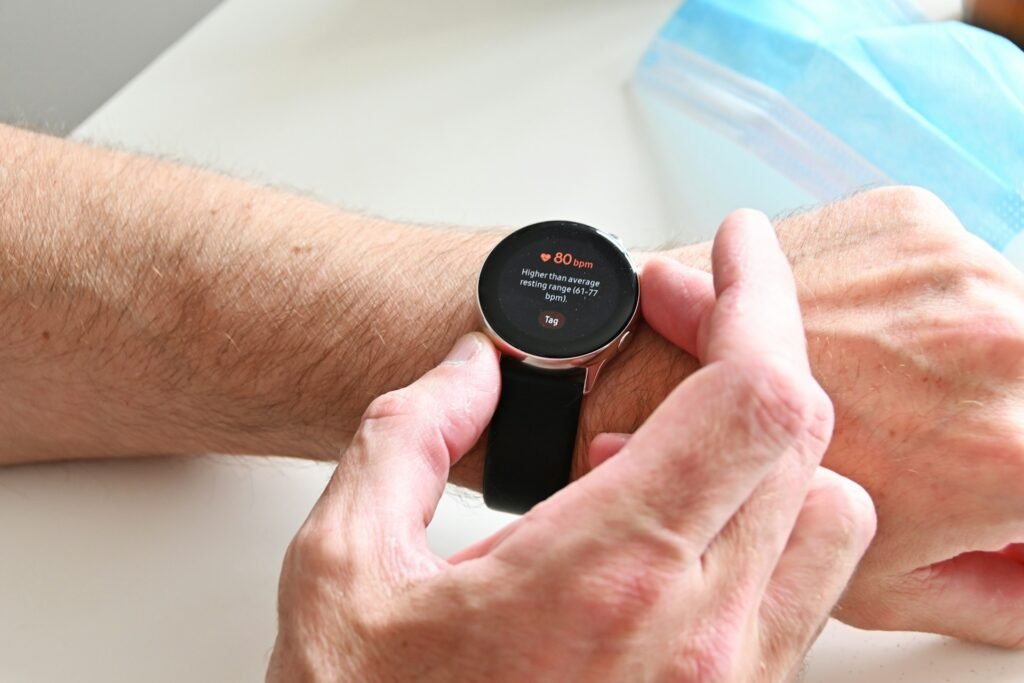
Cardio Recovery Rate (CRR) is a crucial measurement for assessing heart health and physical fitness. It refers to how quickly your heart rate returns to normal after a strenuous workout. Specifically, cardio recovery rate is the difference between your heart rate at peak exercise and your heart rate one to two minutes after stopping the exercise. Usually, people measure this rate in beats per minute (bpm).
A rapid decline in heart rate after exercise is a good indicator of a healthy heart. Health professionals use this metric to evaluate an individual’s cardiovascular fitness and to spot potential heart-related issues. According to information from Cleveland Clinic, the cardio recovery rate can provide significant insights into your risk for future heart disease (Cleveland Clinic). For instance, a slower decrease in heart rate post-exercise may signal an increased risk of heart diseases.
Monitoring the cardio recovery rate is not just pivotal for athletes but for individuals at varying levels of fitness. Health experts suggest aiming for a decrease of at least 18 beats per minute after the cessation of activity as a sign of decent heart recovery capacity. Research continually supports the use of cardio recovery rate as a reliable measure for predicting heart health outcomes and optimizing training regimes. By understanding and tracking this rate, individuals can better manage their exercise routines and overall health.
For more detailed insight into effective cardiovascular exercises, you might find our page on steady-state cardio examples beneficial, which discusses various workouts that can influence heart rate recovery positively.
Methods to Calculate Cardio Recovery Rate
Calculating your Cardio Recovery Rate (HRR) is a straightforward but powerful way to assess your heart’s ability to return to normal functioning after exertion. There are a few common methods healthcare providers and individuals can use, depending on the equipment available and the details required.
One-Minute Recovery Method:
- Procedure: Immediately after you stop your intense exercise, rest completely for one minute. Measure your heart rate at the end of this minute.
- Calculation: Subtract this one-minute post-exercise heart rate from your peak heart rate during exercise. The result is your HRR in beats per minute (bpm).
- Example: If your peak heart rate was 180 bpm, and it dropped to 160 bpm after one minute, your HRR is 20 bpm.
Extended Recovery Method:
- Procedure: Similar to the one-minute method, but instead of one minute, you measure your heart rate after two to five minutes of rest.
- Use: Particularly useful in clinical settings to assess more gradual recovery phases and provide deeper insight into cardiovascular health.
According to Cleveland Clinic, the faster your heart rate returns to its resting state, generally the better cardiovascular condition you’re in. People typically consider an HRR of 18 bpm or more healthy. (source).
For those involved in regular exercise or training, linking HRR measurements with specific workout sessions can yield insights into how different intensities and types of workouts affect cardiovascular recovery. To explore various effective cardiovascular exercises, visit our page on What Cardio Machine Burns the Most Calories.
Always share any self-obtained HRR details with your healthcare provider to interpret what these figures may mean for your overall health and fitness strategy.
The Clinical Significance of Cardio Recovery Rate
Heart rate recovery (HRR), measuring how quickly your heart rate returns to normal after exercise, holds critical clinical implications. A rapid decrease in your heart rate after physical activity, generally within the first minute, signifies a healthy heart and efficient autonomic nervous system control. According to the Cleveland Clinic, a standard measure of good heart rate recovery is a drop of 18 beats or more after one minute of rest post-exercise (Cleveland Clinic, 2022).
Clinically, HRR serves as a valuable diagnostic tool. Healthcare providers utilize HRR to assess the risk of cardiovascular diseases, including coronary artery disease, heart failure, and hypertension. Additionally, abnormal HRR readings could indicate potential autonomic nervous system dysfunction, which plays a crucial role in cardiovascular health. This aspect of HRR measurement gives doctors a deeper insight into an individual’s mortality risk and helps in evaluating the effectiveness of prescribed treatments.
For anyone involved in regular physical training or recovering from cardiac conditions, understanding and monitoring HRR can be pivotal. It not only indicates current heart health but also aids in planning appropriate exercise regimens that improve cardiovascular response and overall fitness.
For more detailed insights on how heart rate recovery can influence your workout plans, consider reading about benefits of steady state cardio. This information can help individuals tailor their exercise habits to improve their HRR and cardiovascular health.
Variables That Affect Cardio Recovery Rate

Photo by Jonathan Borba on Unsplash
The rate at which one’s heart rate returns to normal after exercise, known as the cardio recovery rate, is impacted by several key factors. These variables can significantly influence how quickly the heart rate normalizes and may include age, fitness level, and health conditions.
Age: Recovery rates tend to slow as individuals age. A study revealed that heart rate recovery declines prominently after the age of 60, which could indicate a decrease in the efficiency of autonomic control related to aging Sydó et al., 2018.
Physical Fitness: People who are physically fit usually experience faster heart rate recovery compared to those who are less fit. Improvements in cardio recovery rates are seen through regular aerobic exercises that enhance cardiovascular system efficiency.
Health Conditions: Various health conditions such as diabetes, obesity, and hypertension have been associated with slower heart rate recovery. These conditions impact the autonomic nervous system’s ability to regulate heart rate effectively. The study by Sydó et al., 2018, also confirms that factors like poor cardiorespiratory fitness and current smoking are negatively correlated with heart rate recovery.
Understanding the underlying factors affecting cardio recovery can be crucial for tailoring personal exercise programs and for identifying potential health issues. For further reading on optimizing cardiovascular health through exercise, consider visiting our page on the benefits of cardio in the morning. This provides detailed insights into how different timings and types of cardio workouts influence overall cardiovascular health.
Ideal Cardio Recovery Rate Values
When monitoring heart health through exercise, a crucial metric is the Cardio Recovery Rate (HRR). Typically, a healthy HRR is 18 bpm or higher, calculated by observing the drop in heart rate from peak exercise to one minute post-activity (Cleveland Clinic).
However, “ideal” recovery rates can vary based on several factors including age, presence of cardiovascular disease, and the type of exercise performed. For healthy individuals without heart disease, quicker recovery times generally indicate better cardiovascular fitness and lower long-term risks for heart diseases.
For those involved in fitness programs or looking to monitor their heart health more closely, consulting with healthcare providers is advisable to understand personal HRR targets and implications. Learning about HRR can aid in developing effective cardiovascular training routines. For related read, you might find our article What is Zone 2 Cardio helpful, which discusses different intensity zones in cardiovascular workouts.
Strategies to Enhance Cardio Recovery Rate
Improving your cardio recovery rate is achievable by focusing on enhancing your physical fitness, especially your aerobic capacity. Regular aerobic exercises like running, cycling, swimming, and brisk walking are effective in improving the efficiency of your heart and lungs. According to the Centers for Disease Control and Prevention (CDC), adults should aim for at least 150 minutes of moderate-intensity or 75 minutes of vigorous-intensity aerobic activity each week Trusted Source.
In addition to increasing physical activity, avoiding negative habits is crucial. For instance, smoking has been shown to impair aerobic fitness and should be avoided to help improve your heart rate recovery Trusted Source.
For those starting from a less active lifestyle, gradually building up to these exercise goals is important. Begin with lighter activities, such as short walks or using an exercise bike, and progressively increase the intensity as your fitness improves.
For more detailed exercise plans and tips on activities suitable for all fitness levels, consider visiting our guide on low-impact cardio for bad knees. This can be particularly useful for those with joint concerns or starting out on their fitness journey. Remember, enhancing your heart rate recovery is not just about pushing your limits but doing so in a safe and sustainable manner.
Research Findings on Cardio Recovery Rate
Recent studies on heart rate recovery (HRR) after exercise provide fresh insights into its usefulness for both fitness assessment and preventive medicine. In research published in the International Journal of Environmental Research and Public Health, an analysis of 1234 cycle ergometry performance protocols highlighted significant findings regarding HRR (Römer & Wolfarth, 2023).
The study demonstrated that there is a moderate correlation between HRR and weight-related performance at the individual anaerobic threshold (IAT). Particularly, the coefficient of determination (R² = 0.250) indicates a moderate strength of association, suggesting that HRR can somewhat predict physical fitness, but should not be relied upon as the sole indicator. The importance of considering other factors, like the specific sports and athlete’s training background, was also emphasized.
Furthermore, gender seems to influence the correlation between HRR and physical performance, with different trends observed between male and female subjects. This suggests personalized training and recovery protocols might be beneficial to account for these differences.
For anyone interested in a deeper understanding of how aerobic activities like running might influence heart rates and recovery, a look at other resources such as Does Running Burn Belly Fat? might provide additional practical insights.
This research underscores the complex nature of physiological responses to exercise and the need for comprehensive approaches in using HRR as a reliable measure of physical fitness and cardiological health in diverse populations.
Summary: Why Monitor Cardio Recovery Rate?

Photo by Caley Vanular on Unsplash
Monitoring your Cardio Recovery Rate (HRR) is crucial for several reasons, primarily concerning your heart health and overall fitness. HRR measures how quickly your heart rate returns to normal after intense activity and is a key indicator of your cardiovascular health. A rapid recovery rate is generally associated with a healthy heart, while a slower rate may suggest cardiovascular problems or other health issues.
Research suggests that a good HRR one minute after exercise should ideally be 18 beats per minute or more (Cleveland Clinic). This metric is not only used to assess the current state of your heart health but also to predict future heart conditions. Given its role in diagnosing potential heart diseases, tracking HRR can guide early preventive measures and influence treatment plans aimed at enhancing heart function.
Moreover, for athletes and individuals involved in regular physical training, monitoring HRR can provide insights into fitness levels and workout effectiveness, helping to tailor exercise routines for optimal results. Recognizing abnormal HRR readings early can prompt further investigation and intervention, potentially staving off severe health complications.
For more information on how to implement cardiovascular exercises effectively and the benefits of different types of cardio workouts, refer to our guide on cardio exercises. Monitoring your HRR is not just about knowing numbers; it’s about understanding and taking control of your heart health and overall well-being.